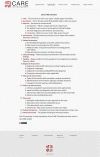Oral carcinoma cuniculatum, an unacquainted variant of oral squamous cell carcinoma: A systematic review
- PMID: 30607347
- PMCID: PMC6305781
- DOI: 10.5624/isd.2018.48.4.233
Oral carcinoma cuniculatum, an unacquainted variant of oral squamous cell carcinoma: A systematic review
Abstract
Purpose: Oral carcinoma cuniculatum is a rare well-differentiated variant of oral squamous cell carcinoma. The purpose was to systematically review its unique features to differentiate it from other variants as verrucous carcinoma, papillary squamous cell carcinoma and well-differentiated squamous cell carcinoma.
Materials and methods: A systematic review was performed using MEDLINE, Dentistry and Oral Sciences Source and PubMed databases and any existing articles related to the research subject missed in the search strategy to screen ones reporting cases occurring exclusively in the oral cavity in English literature. Variables analyzed included clinical, etiologic, imaging, histopatholgical features, treatment, follow-up and survival rates.
Results: From 229 hits, 17 articles with 43 cases were included in the systematic review. Clinically it showed a female predilection with pain and/or ulceration of a relatively long duration and exudation being the most common symptoms. Histologically, it showed more endophytic features comprising well-differentiated squamous epithelium with absent or minimal cytological atypia and multiple keratin filled crypts or cuniculus. Inflammatory stromal reaction and discharging abscesses were reported in most of the cases. Bone destruction was predominant in most imaging features. Complete surgical resection with a safety margin was the treatment of choice in most of the cases with few recorded recurrence cases.
Conclusion: Apprehensive knowledge of oral carcinoma cuniculatum unique features is essential to avoid its misdiagnosis and provide proper treatment especially for recurrent cases.
Keywords: Carcinoma, Squamous Cell; Carcinoma, Verrucous; Mouth.
Figures
Similar articles
-
Oral carcinoma cuniculatum: an unacquainted entity with diagnostic challenges-a case report.J Egypt Natl Canc Inst. 2022 Jan 17;34(1):3. doi: 10.1186/s43046-021-00101-4. J Egypt Natl Canc Inst. 2022. PMID: 35037108
-
Carcinoma Cuniculatum of the Oral Cavity: A Series of 6 Cases and Review of Literature.Head Neck Pathol. 2022 Mar;16(1):213-223. doi: 10.1007/s12105-021-01340-6. Epub 2021 Jun 2. Head Neck Pathol. 2022. PMID: 34076846 Free PMC article. Review.
-
Carcinoma cuniculatum of the jaw: a rare variant of oral carcinoma.Oral Surg Oral Med Oral Pathol Oral Radiol Endod. 2002 Nov;94(5):601-8. doi: 10.1067/moe.2002.126913. Oral Surg Oral Med Oral Pathol Oral Radiol Endod. 2002. PMID: 12424455 Review.
-
Oral Carcinoma Cuniculatum: A New Entity in the Clinicopathological Spectrum of Oral Squamous Cell Carcinoma.J Clin Diagn Res. 2017 Jan;11(1):ZD37-ZD39. doi: 10.7860/JCDR/2017/23437.9226. Epub 2017 Jan 1. J Clin Diagn Res. 2017. PMID: 28274074 Free PMC article.
-
Oral carcinoma cuniculatum: two cases illustrative of a diagnostic challenge.Oral Surg Oral Med Oral Pathol Oral Radiol. 2013 Oct;116(4):457-63. doi: 10.1016/j.oooo.2013.06.006. Oral Surg Oral Med Oral Pathol Oral Radiol. 2013. PMID: 24035112
Cited by
-
Epidemiology and incidence of oral squamous cell carcinoma in the Iraqi population over 5 years (2014-2018).Health Sci Rep. 2023 Apr 11;6(4):e1205. doi: 10.1002/hsr2.1205. eCollection 2023 Apr. Health Sci Rep. 2023. PMID: 37064317 Free PMC article.
-
METTL3 Facilitates Oral Squamous Cell Carcinoma Tumorigenesis by Enhancing c-Myc Stability via YTHDF1-Mediated m6A Modification.Mol Ther Nucleic Acids. 2020 Jun 5;20:1-12. doi: 10.1016/j.omtn.2020.01.033. Epub 2020 Feb 4. Mol Ther Nucleic Acids. 2020. PMID: 32145676 Free PMC article.
-
Treatment of recurrent oral carcinoma cuniculatum with immune checkpoint blockade: A case report and literature review.Oral Oncol Rep. 2025 Jun;14:100746. doi: 10.1016/j.oor.2025.100746. Epub 2025 May 13. Oral Oncol Rep. 2025. PMID: 40574746 Free PMC article.
-
"Salivary LINC00657 and miRNA-106a as diagnostic biomarkers for oral squamous cell carcinoma, an observational diagnostic study".BMC Oral Health. 2023 Dec 12;23(1):994. doi: 10.1186/s12903-023-03726-0. BMC Oral Health. 2023. PMID: 38087258 Free PMC article.
-
Management and treatment of four cases of oral carcinoma cuniculatum.J Korean Assoc Oral Maxillofac Surg. 2024 Feb 29;50(1):35-40. doi: 10.5125/jkaoms.2024.50.1.35. J Korean Assoc Oral Maxillofac Surg. 2024. PMID: 38419519 Free PMC article.
References
-
- Aird I, Johnson HD, Lennox B, Stansfeld AG. Epithelioma cuniculatum a variety of squamous carcinoma peculiar to the foot. Br J Surg. 1954;42:245–250. - PubMed
-
- Lawrence-Brown MM, Gollow IJ, Lam TP, Frost FA. Carcinoma cuniculatum of the abdominal wall. Med J Aust. 1984;140:668–669. - PubMed
-
- Barreto JE, Velazquez EF, Ayala E, Torres J, Cubilla AL. Carcinoma cuniculatum: a distinctive variant of penile squamous cell carcinoma: report of 7 cases. Am J Surg Pathol. 2007;31:71–75. - PubMed



